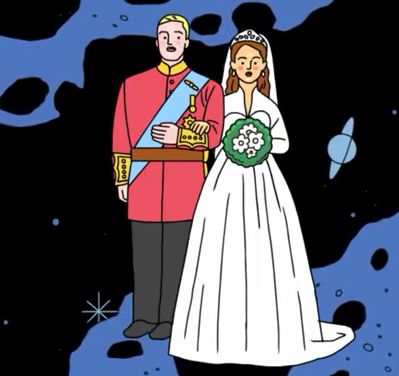There have been many different things written and said about marriage.
已經有各種不同文字記錄和討論著關于婚姻的話題。
From the sweetly inspirational to the hilariously cynical.
從甜蜜勵志的到詼諧諷刺的。
But what many of them have in common is that they sound like they express a universal and timeless truth,
但是他們的共同點是他們聽上去像在表達著一個橫貫中西,縱橫古今的真理。
when in fact nearly everything about marriage, from its main purpose to the kinds of relationships it covers to the rights and responsibilities involved,
而事實上,幾乎所有關于婚姻從她的主要意圖,到其中牽涉的各種關系,再到與之相關的義務,
has varied greatly between different eras, cultures and social classes.
在不同的時代、文化和社會階級間都大相徑庭。
So, let's take a quick look at the evolution of marriage.
那么,就讓我們快速瀏覽一下婚姻的演變。
Pair bonding and raising children is as old as humanity itself.
成家立室和養(yǎng)育子女就和人類本身一樣歷史悠久。

With the rise of sedentary agricultural societies about 10,000 years ago,
隨著定居型的農耕社會的興起,大約一萬年前,
marriage was also a way of securing rights to land and property by designating children born under certain circumstances as rightful heirs.
婚姻也是一種確保土地權和財產權的方式,(這種方式)通過指定在某些情況下出生的孩子為合法繼承人(來實現)。
As these societies became larger and more complex, marriage became not just a matter between individuals and families,
隨著這些社會變得更大更復雜,婚姻已不僅僅成為個人和家庭間的事情,
but also an official institution governed by religious and civil authorities.
她也成為了由宗教和民事行政機構管轄的一種官方制度。
And it was already well established by 2100 B.C.
至公元前2100年,這種制度已經被完善地建立起來。
when the earliest surviving written laws in the Mesopotamian Code of Ur-Nammu provided many specifics governing marriage,
那個時候訂立了現存最早的成文法并記錄在美索不達米亞的烏爾納姆法典中,該法律規(guī)定了許多細節(jié)來制約管理婚姻,
from punishments for adultery to the legal status of children born to slaves.
從對通奸的處分到出身于奴隸家庭孩子的合法身份。
Many ancient civilizations allowed some form of multiple simultaneous marriage.
許多古代文明允許多重婚姻制度。
And even today, less than a quarter of the world's hundreds of different cultures prohibit it.
甚至到今日,在全世界幾百種不同的文化中,只有四分之一的文化是禁止多重配偶制。
But just because something was allowed doesn't mean it was always possible.
但是,有些事情存在并不代表它總是可行的。
Demographic realities, as well as the link between marriage and wealth,
人口的現實問題,以及婚姻和財富的連帶關系,
meant that even though rulers and elites in Ancient Mesopotamia, Egypt and Israel had multiple concubines or wives,
意味著即使在古代的美索不達米亞,埃及和以色列的統(tǒng)治者和精英貴族妻妾成群,
most commoners could only afford one or two tending towards monogamy in practice.
但大部分的老百姓只負擔得起一個或者兩個妻子,所以實際情況是更趨向于一夫一妻制。
In other places, the tables were turned, and a woman could have multiple husbands as in the Himalayan Mountains
在其他一些地區(qū),情況正好相反,一位女性可以有多位丈夫,比如在喜馬拉雅山地區(qū),
where all brothers in a family marrying the same woman kept the small amount of fertile land from being constantly divided into new households.
那里有一個家庭中的所有男性與同一名女性結了婚,他們用婚姻保護著一小片有限而肥沃的土地,以防止它被新成立的家庭不斷分割。
Marriages could vary not only in the number of people they involved but the types of people as well.
婚姻可以多種多樣,不僅是其參與其中的人數也包括人的性別類型。
Although the names and laws for such arrangements may have differed,
雖然關于同性婚姻的名稱和法律可能有所不同,
publicly recognized same-sex unions have popped up in various civilizations throughout history.
但是公開承認同性婚姻已經在歷史長河中的各種文明里出現。


